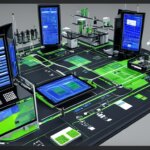Table of Contents
Software is an integral part of our everyday lives. It powers our computers, devices, and applications, enabling us to perform a wide range of tasks efficiently. In this guide, we will explore the concept of software and its various types and uses.
So, what is software? At its core, software refers to a collection of instructions, data, and programs that control the operation of computers. Unlike hardware, which encompasses the physical components, software is the variable part that drives functionality.
There are two primary categories of software: application software and system software. Application software serves specific needs and performs tasks like word processing, image editing, and web browsing. System software, on the other hand, runs the computer’s hardware and provides a platform for applications to run smoothly.
Additionally, there are other types of software, such as programming software, middleware, and driver software. Programming software assists developers in writing, testing, and debugging other software programs. Middleware acts as a mediator between system software and applications, enabling seamless integration. Driver software controls the devices and peripherals connected to a computer, allowing them to perform specific tasks.
Software has evolved significantly over time. Previously, it used to be sold along with hardware, but now it can be easily downloaded over the internet. This makes it more accessible and convenient for users to install and update their software as needed.
Examples of software include office suites like Microsoft Office and Google Workspace, graphics software such as Adobe Photoshop, databases like MySQL and Oracle, web browsers like Google Chrome and Mozilla Firefox, and communication platforms like Slack and Microsoft Teams.
Now that we have a basic understanding of what software is, let’s delve deeper into its different types, functions, and how it works.
The Different Types of Software
When it comes to software, there are various types that cater to different needs and functions. Understanding the different categories of software can provide insight into how they work and what they can be used for.
1. Application Software
Application software is the most common type that users interact with on a daily basis. It includes programs like office suites, graphics software, databases, web browsers, and communication platforms. Application software is designed to fulfill specific tasks and meet the needs of end users.
2. System Software
System software, on the other hand, is essential for running the computer’s hardware and providing a platform for applications. It includes the operating system, firmware, and system utilities. System software works in the background and coordinates the hardware and software of a computer, ensuring smooth operation.
3. Programming Software
Programming software is used by developers to write, test, and debug other software programs. It provides the necessary tools and resources for programming, allowing developers to create applications, scripts, and software solutions.
4. Middleware
Middleware acts as a mediator between system software and applications. It enables different software components to work together seamlessly, facilitating communication and data exchange between various systems and platforms.
5. Driver Software
Driver software controls devices and peripherals connected to a computer. It allows these devices to perform specific tasks by enabling communication between the hardware and software components.
Understanding the different types of software is crucial for selecting the right tools and technologies for specific tasks and applications. Whether it’s using application software for productivity or system software for hardware management, each type plays a vital role in the functioning of software systems.
How Software Works
When it comes to understanding how software works, it’s important to differentiate between application software and system software. While both types play crucial roles in the operation of a computer, they function in different ways.
Application software is designed to perform specific tasks for end users. These tasks can range from writing reports to navigating websites. To function properly, application software relies on an operating system and other supporting system software. This type of software can be installed on a computer’s hard drive and does not require an internet connection to work.
In contrast, web applications operate solely through internet access. The components responsible for their functionality are located on a server rather than the user’s computer. This allows for easier updates and maintenance but requires a constant internet connection.
System software, on the other hand, works behind the scenes to coordinate the hardware and other software components of a computer. It provides a platform for application software to run efficiently. The operating system, which is a type of system software, manages tasks such as memory management, file system operations, and device drivers. System software ensures the smooth operation of the computer and is essential for high-level application software to perform specific actions.
Overall, understanding how software works involves recognizing the differences between application software and system software. While application software caters to end users and performs specific tasks, system software works in the background to coordinate and optimize the overall functionality of a computer system.
| Application Software | System Software |
|---|---|
| Performs tasks for end users | Coordinates hardware and software |
| Installed on hard drive | Provides a platform for applications |
| Works without internet connection | Eases the operation of computer hardware |
The Design and Implementation of Software
The software development lifecycle is a structured approach that guides the creation of software from conception to deployment. It involves several stages, including planning, analysis of user requirements, software design, implementation, and software testing. Each stage contributes to the overall success and quality of the software product.
The design process plays a critical role in software development. It encompasses various activities that transform user requirements into a tangible software structure. The design phase includes architectural design, which identifies the system’s structure and components. It also involves high-level design, which determines the data flow and system functionality. Additionally, detailed design focuses on the implementation details, such as code structure and algorithms.
“Software design is about converting the user’s needs into a form that can be coded.”
During the design phase, software engineers create a blueprint for the software, mapping out how it will be implemented. They consider factors such as performance, scalability, and maintainability. The design process is an iterative one, where engineers refine and improve the design as they progress.
Once the design is finalized, the implementation phase begins. This phase involves writing the actual code based on the design specifications. The implementation process requires expertise in programming languages and follows industry standards and best practices. Software developers carefully translate the design into executable code, ensuring accuracy and efficiency.

After the completion of the implementation phase, software testing is conducted to identify and rectify any technical issues. Software testing verifies the functionality, performance, and usability of the software. It ensures that the software meets the intended requirements and performs as expected.
“Software testing is essential to ensure the reliability and quality of the final product.”
Overall, the design and implementation stages are vital components of the software development lifecycle. They lay the foundation for the successful creation of software products that meet user needs and adhere to industry standards.
Maintaining Software Quality
Software quality is a crucial aspect of any software development project. It determines whether the software meets its functional and nonfunctional requirements, ensuring it performs as intended and satisfies user expectations.
Functional requirements define what the software should do, specifying its desired features and capabilities. Nonfunctional requirements, on the other hand, focus on how the software should work, encompassing factors such as performance, security, and usability.
To ensure software quality, rigorous software testing is essential. Testing helps detect and solve technical issues in the source code and assesses the overall functionality, performance, security, and compatibility of the software product.
However, software quality goes beyond mere functionality and performance. It encompasses multiple dimensions that contribute to the overall user experience. These dimensions include:
- Accessibility
- Compatibility
- Efficiency
- Functionality
- Installability
- Localization
- Maintainability
- Performance
- Portability
- Reliability
- Scalability
- Security
- Testability
- Usability
These dimensions ensure that the software not only works correctly but also meets user expectations in terms of ease of use, reliability, security, and adaptability.
Developers continuously strive to maintain software quality by adapting and modifying the software to meet evolving user needs and improve its features. This involves implementing updates, bug fixes, and enhancements based on user feedback and market demands.
By prioritizing software quality, developers enhance user satisfaction, build trust, and maximize the value of their software products.
The Role of Operating Systems
Operating systems (OS) play a crucial role in managing computer hardware and enhancing user experience. By providing a common set of controls, operating systems facilitate easier operation of computers and enable the smooth execution of application software. From desktops and laptops to mobile phones and specialty devices like iPods and game consoles, most computing devices rely on operating systems to function effectively.
One of the primary functions of operating systems is hardware control. They serve as intermediaries between software and hardware, ensuring seamless interaction between the two. By managing hardware resources such as memory, processors, and peripherals, operating systems optimize performance and enable applications to run efficiently.
Leading technology giants like Apple and Microsoft develop their own operating systems, tailoring them to their specific devices and ecosystem. Additionally, specialty firms collaborate with manufacturers to design operating systems for various devices in niche markets. This collaborative effort ensures that operating systems are customized to meet the unique requirements of different hardware configurations.
Moreover, operating systems are essential for embedded systems, which are integrated into everyday products and services. Embedded systems rely on operating systems to manage hardware components, unify software interfaces, and enable the creation of smarter and more advanced products. By extending the principles of Moore’s Law, embedded systems enhance functionality, connectivity, and intelligence in a wide range of industries, including automotive, healthcare, and smart home devices.
FAQ
What is software?
Software refers to a set of instructions, data, or programs that operate computers and execute specific tasks. It is the variable part of a computer, in contrast to hardware, which refers to the physical aspects.
What are the different types of software?
The main types of software are application software, system software, programming software, middleware, and driver software. Application software fulfills specific needs and performs tasks, while system software runs the computer’s hardware and provides a platform for applications.
How does application software work?
Application software consists of programs that perform tasks for end users, such as writing reports or navigating websites. These programs need an operating system and other supporting system software to function properly. Application software can be installed on a computer’s hard drive and does not require an internet connection to work.
How does system software work?
System software runs in the background and coordinates the hardware and software of a computer. It is essential for high-level application software to perform specific actions.
What is the software development lifecycle?
The software development lifecycle involves planning, analyzing user requirements, designing the software structure, implementing the design, and testing the software for issues and usability.
How is software quality measured?
Software quality is measured by assessing if the software meets its functional and nonfunctional requirements. Functional requirements specify what the software should do, while nonfunctional requirements determine how the system should work. Software testing detects and solves technical issues in the source code and assesses the overall usability, performance, security, and compatibility of the product.
What is the role of operating systems?
Operating systems provide a common set of controls for managing computer hardware. They control the hardware and interact with users, making it easier to operate computers and write application software. Most computing devices have operating systems, including desktops, laptops, mobile phones, and specialty devices like iPods and video game consoles.












